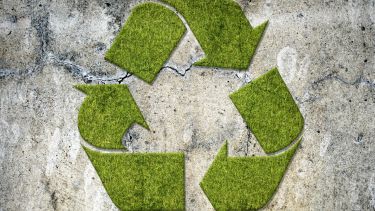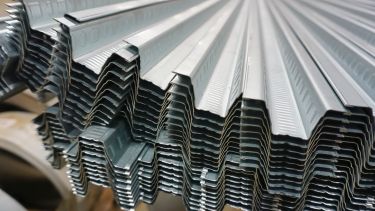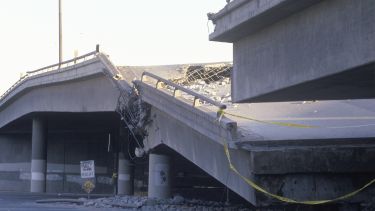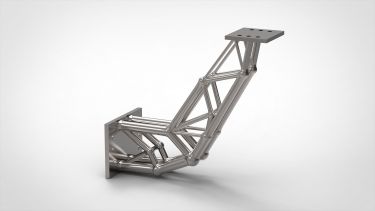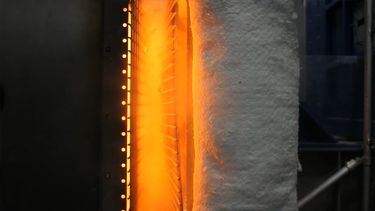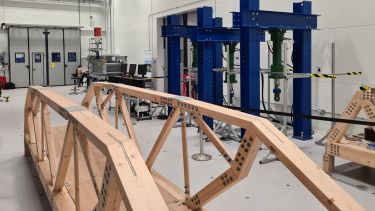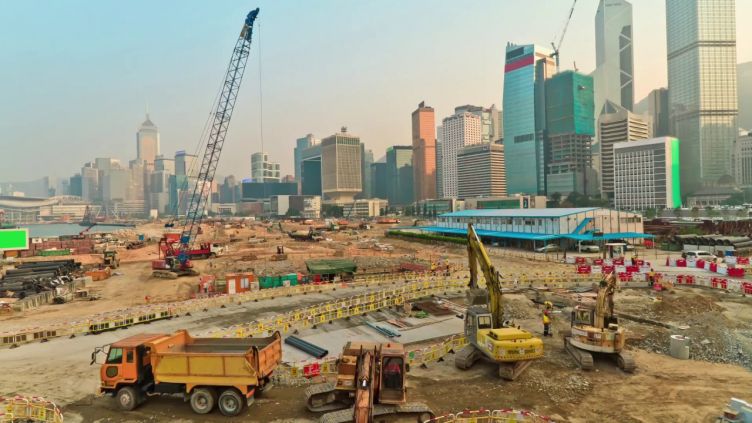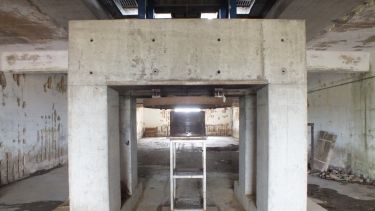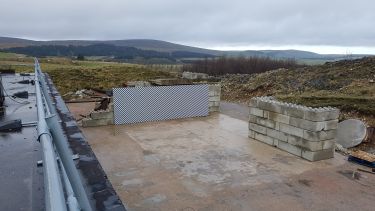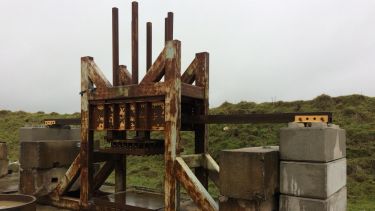Structural Engineering & Materials Group
Our Structural Engineering & Materials research group stands as one of the largest of its kind in the UK, bringing together people from diverse expertise under the common goals of advancing resource efficiency, sustainability and resilience.
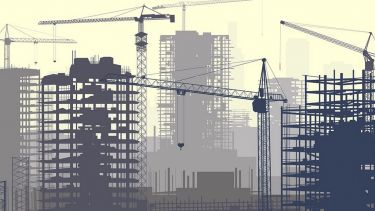
Projects | Facilities | People
Leveraging the complimentary expertise of our team in the key areas of materials, structural engineering and computational mechanics we develop a fundamental understanding of the behaviour of components and structures, so that they can be tailored and adapted to meet the demands of an ever-changing society by taking advantage of novel materials and innovative manufacturing techniques.
Research topics
Our research activities cover all aspects of structural engineering including: traditional and innovative construction materials; rehabilitation solutions and novel structural systems; resilient buildings and infrastructure under extreme load events such as earthquakes, blast and impact and fire; computational mechanics and building physics; lightweight and sustainable construction; digital manufacturing and robotics.
- Concrete Structures
-
Our work covers all aspects of concrete, concrete technology and sustainable solutions, Fibre Reinforced Concrete, Fibre Reinforced Polymer strengthening and reinforcements, structural and material testing and characterisation, short and long-term structural behaviour, analysis, innovation, and design.
Group members:
Maurizio Guadagnini, Iman Hajirasouliha, Shan-Shan Huang, Zuhal Ozdemir, Kypros Pilakoutas & Giacomo Torelli - Steel and Composite Structures
-
Our current research activities are focussed on cold-formed steel structures considering local stability, joint performance and modelling under fire and dynamic loading, additive manufacturing, structural optimisation, performance-based seismic design, tubular structures, performance of steel composite structures in fire, steel and timber hybrid structures, the role of steel structures in building adaptability, and design for deconstruction and reuse of steel structures.
Group members:
Ian Burgess, Buick Davison, Shan-Shan Huang, Iman Hajirasouliha, Andrew Liew & Xiang Yun - Earthquake Engineering
-
Our current research activities cover all aspects of earthquake engineering including seismic hazard and risk assessment, vulnerability assessment, performance-based design, active/semi-active/passive seismic control systems, soil-structure interaction, and development of novel strengthening techniques.
Group members:
Maurizio Guadagnini, Iman Hajirasouliha, Zuhal Ozdemir, Kypros Pilakoutas, Elisabeth Bowman & Giacomo Torelli - Computational Mechanics & Design
-
Our research involves computer modelling to develop a deeper understanding of the mechanical behaviour of structures and materials and to facilitate the design of more resource efficient constructions.
Group members:
Matthew Gilbert, Zuhal Ozdemir, René de Borst, Luca Susmel, Andrew Liew, Colin Smith, Andy Tyas, Helen Fairclough & Linwei He - Fire Engineering
-
Our research covers structural fire engineering and fire science. We conduct both experimental and numerical work to understand how structures behave in fire and how fire develops. Our current focus is to work toward a harmony between fire safety and sustainability, e.g. investigating the performance of novel sustainable low carbon structural systems and materials in fire.
Group members:
Professor Ian Burgess, Professor Buick Davison, Dr Shan-Shan Huang, Dr Martyn McLaggan, Dr Giacomo Torelli - Intelligent Infrastructure
-
Research focuses on the development and application of digital design and manufacturing methods and innovative monitoring, sensing and analysis techniques to tackle current and future challenges in the field of constructed infrastructure. The aim is to enhance productivity and sustainability, working in close collaboration with practitioners responsible for the design, construction, operation and maintenance of buildings, bridges and other constructed infrastructure. The Intelligent Infrastructure group is affiliated to the Integrated Civil and Infrastructure Research (ICAIR) Centre, which provides excellent facilities for large-scale testing of concrete, masonry, steel and timber components and structures.
Group members:
Matthew Gilbert, Giacomo Torelli & Andrew Liew
Research projects
Our research builds upon a culture of nurturing and addressing industry needs in collaboration with a range of stakeholders to provide innovative solutions to challenging problems.
Current Projects:
Behavior of the interfaces between steel and timber members at elevated temperatures
New Generation of Resilient Lightweight Cold-Formed Steel Structures
Hybrid Lightweight Structural Systems for Low-Cost Housing (HYLIGHTS)
LIGHTSTEEL: New Generation of Lightweight Steel Elements for Sustainable Resilient Construction
Exploiting the resilience of masonry arch bridge infrastructure
Recent Projects:
Practical 3D model of masonry arch bridges and tunnel linings
RCUK-TUBITAK Research Partnerships
Further projects can be found on the Our Research Projects webpage
Facilities and resources
Our engineering activities make use of a variety of innovative facilities and resources.
-
Blast & Impact
-
Characterisation of Blast Loading (CoBL)
- Measuring reflected pressures from both free-air and buried explosives.
- X-shaped array of 17 Hopkinson pressure bars.
- Able to investigate the effects of confining and mitigating materials on the explosive output.
- Unique equipment world-wide.
Blast Pad
- General purpose explosives arena for near- and far-field testing.
- High speed video and zebra wall, for tracking of shock front.
- Tests up to 1000 grams of high explosive are possible.
- Measurements of incident and reflected pressures possible, with world-leading levels of repeatability.
Applique
- Investigations into the performance of armour systems against buried explosives.
- Benchmark testing for Dstl on new and novel armour systems.
- Tests up to 1000 grams of high explosive are possible.
- Testing done at ½ scale of AEP-55.
- Stereo high speed video possible for back face DIC.
Internal pressure measurement
- Capable of containing 50 gram high explosive charges.
- Measurements of internal pressure currently possible, with rapid temperature measurement systems being currently developed
Large Gas Gun
- 120 mm smooth bore gun.
- Capable of launching a 5 kg mass at up to 600 m/s.
- Containment cell capable of soft capture of projectiles.
- Protective systems up to ~2 x 2 x 1.5 m can be accomodated.
Fragmentation Cell
- Reinforced, buried chamber
- Capable of internal blasts of up to 500 g of high explosive.
- Containment cell capable of soft capture of fragments.
- High speed video to determine fragment velocity also possible.
- Measurements of internal pressure (QSP).
SHPB Apparatus
- Compressive testing of materials in unconfined, fully confined and a unique triaxially confined apparatus.
- Range of bars available to test materials from foams up to high strength steels.
- Direct impact, tensile and Taylor testing also possible.
- Fire Engineering
-
- Radiant panel heating and loading system which can deliver very precisely controlled heating up to 100 kW/m2 and 2500 kN of compression onto the test specimens.
- Electric furnace of 1 m x 1 m x 1 m inner dimensions and 1100 °C maximum temperature, working with a load frame and strong floor for loaded high temperature tests.
- Split furnace which can wrap a testing machine for high temperature compression and tensile testing. Inner dimensions: 37 cm width, 40 cm length and 60 cm height. Maximum temperature: 700 °C.
-
Structural Testing Facilities/Equipment
-
Digital servo-controller
- CONTROL CUBE Digital servo-controller
- SIGNAL CUBE Modular signal conditioning / acquisition system
Servo control actuators
- ESH 1000kN 100mm stroke tension/compression
- Losenhausen 250kN 500kN 150mm stroke tension/compression
- Eland 10kN 600mm stroke 50kN 200mm stroke 130kN 400mm stroke tension/compression
Universal testing machines
- ESH 1000kN 100mm stroke tension/compression with thermal chamber to 200° C
- Shimadzu AGS-X 10kN tension/compression
- Shimadzu AGS-X 300kN tension/compression
- Amsler 100kN tension/compression 400kN 1000kN 2000kN compression
Strong floor
- Capacity 1000kN 3m wide by 8m long. Crane 2T access
Strong frame
- Capacity 500kN frame 6.5m long by 4.5m wide by 4m high. Headroom 5m. Crane 2T access
-
Material Testing Facilities/Equipment
-
Universal testing machines:
- CONTROLS 3000kN compression (suitable for testing cylinders and cubes)
- CONTROLS Flexural frame (suitable for testing standard prisms 100x100mm and 150x150mm square sections)
X-Ray diffraction:
- Siemens X-ray diffractometer
X-Ray fluorescence microscopy:
- Advanced scanning and transmission electron microscopy
Thermal analysis:
- Differential scanning and thermal calorimetry
- Graviometric analysis
-
Environmental Conditioning Facilities/Equipment
-
Oxygen permeability apparatus:
- 6 cells for sample sizes 25mm 50mm 100mm 150mm diameter and 50mm thickness
Chloride permeability apparatus:
- 4 cells for sample size 50mm diameter and 50mm thickness
Porosity measurement apparatus:
- Vacuum saturation
Intermittent salt spray cabinet:
- Timer controls switching spray on/off. Purge rate controllable
Cyclic freeze-thaw cabinet:
- 810 litre cyclic curing cabinet
- Temperature range -25°/+70°C
- Temperature Stability ± 0.1°C
- Humidity control between 10% and 98% ± 1%
-
Specialized Testing Facilities/Equipment
-
Multi-axial compression machine for concrete under elevated temperature (MAC2ET)
- This unique device can deliver three independent principal stresses (up to 400 MPa) on 100mm cubes.
- The precision of the measurement system enables stresses and strains to be detected to within 0.2 MPa and 10 microstrain respectively.
People
Our dedicated staff that make this research possible.
Academics
| Name | Research Discipline | Title |
|---|---|---|
| Burgess, Prof. Ian | Steel and Composite Structures | Emeritus Professor of Structural Engineering |
| Clarke, Prof. Sam |
Blast & Impact |
Professor in Blast Geotechnics |
| Davison, Prof. Buick |
Steel & Composite Structures |
Deputy Head of Department Professor of Structural Engineering |
| Fairclough, Dr Helen | Computational Mechanics & Design | Lecturer in Structural Engineering |
| Gilbert, Prof. Matthew |
Computational Mechanics & Design Intelligent Infrastructure |
Professor of Civil Engineering |
| Guadagnini, Dr Maurizio |
Concrete Structures Earthquake Engineering Group |
Senior Lecturer |
| Hajirasouliha, Prof. Iman |
Earthquake Engineering Group Steel & Composite Structures Concrete Structures |
Chair in Structural Engineering |
| He, Dr Linwei | Computational Mechanics & Design | Lecturer in Structural Engineering |
| Huang, Dr Shan-Shan |
Steel & Composite Structures Concrete Structures |
Senior Lecturer in Structural Engineering |
| Liew, Dr Andrew |
Computational Mechanics & Design Intelligent Infrastructure Steel & Composite Structures |
Lecturer in Civil and Structural Engineering |
| Ozdemir, Dr Zuhal |
Concrete Structures Blast & Impact Earthquake Engineering Group |
Lecturer in Structural Engineering |
| Pilakoutas, Prof. Kypros |
Concrete Structures Earthquake Engineering Group |
Professor of Construction Innovation |
| Rigby, Dr Sam | Blast & Impact |
Senior Lecturer in Blast and Impact Engineering |
| Susmel, Prof. Luca | Computational Mechanics & Design | Professor of Structural Integrity |
| Torelli, Dr Giacomo |
Computational Mechanics & Design Intelligent Infrastructure Earthquake Engineering Group |
Lecturer in Civil and Structural Engineering |
| Tyas, Prof. Andrew |
Computational Mechanics & Design Blast & Impact |
DSTL/Royal Academy of Engineering Research Chair in Blast Protection Engineering |
| Yun, Dr Xiang | Steel & Composite Structures | Lecturer in Structural Engineering |
Further Research contacts can be found here.

